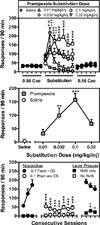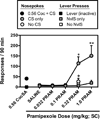Effects of pramipexole on the reinforcing effectiveness of stimuli that were previously paired with cocaine reinforcement in rats
- PMID: 21701814
- PMCID: PMC3800033
- DOI: 10.1007/s00213-011-2382-5
Effects of pramipexole on the reinforcing effectiveness of stimuli that were previously paired with cocaine reinforcement in rats
Abstract
Rationale: Dopamine D(2)-like agonists maintain responding when substituted for cocaine in laboratory animals. However, these effects appear to be mediated by an interaction with stimuli that were previously paired with cocaine reinforcement (CS).
Objectives: To evaluate the extent to which the pramipexole-maintained and pramipexole-induced responding are influenced by cocaine-paired stimuli.
Methods: Rats were trained to nosepoke for cocaine under fixed ratio 1 (FR1) or progressive ratio (PR) schedules of reinforcement. In FR1-trained rats, pramipexole was substituted for cocaine with injections either paired with CSs, or delivered in their absence. The capacity of experimenter-administered pramipexole to induce FR1 and PR responding for CS presentation was evaluated. The effects of altering stimulus conditions, as well as pretreatments with D(2)- (L: -741,626) and D(3)-preferring (PG01037) antagonists on pramipexole-induced PR responding were also evaluated.
Results: When substituted for cocaine, pramipexole maintained responding at high rates when injections were paired with CSs, but low rates when CSs were omitted. Similarly, experimenter-administered pramipexole induced dose-dependent increases in FR1 or PR responding, with high rates of responding observed when the CS was presented, and low rates of responding when CS presentation was omitted. D(2) and D(3) antagonists differentially affected pramipexole-induced PR responding, with L: -741,626 and PG01037 producing rightward, and downward shifts in the dose-response curve for CS-maintained responding, respectively.
Conclusions: These data indicate that pramipexole is capable of enhancing the reinforcing effectiveness of conditioned stimuli, and raise the possibility that similar mechanisms are responsible for the increased occurrence of impulse control disorders in patients being treated with pramipexole.
Figures





References
-
- Barrett AC, Morgan D, Izenwasser S, Picker MJ. Cocaine-like discriminative stimulus effects and [3H]dopamine uptake inhibition produced by selected partial opioid agonists. Behav Pharmacol. 2001;12:225–235. - PubMed
-
- Boulougouris V, Castane A, Robbins TW. Dopamine D2/D3 receptor agonist quinpirole impairs spatial reversal learning in rats: investigation of D3 receptor involvement in persistent behavior. Psychopharmacology (Berl) 2009;202:611–620. - PubMed
-
- Caine SB, Koob GF. Modulation of cocaine self-administration in the rat through D-3 dopamine receptors. Science. 1993;260:1814–1816. - PubMed
Publication types
MeSH terms
Substances
Grants and funding
LinkOut - more resources
Full Text Sources
Research Materials

